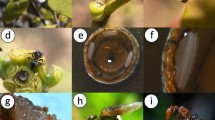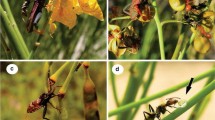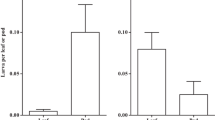Abstract
Ant–plant mutualisms may provide indirect evidence for costs of antiherbivore defenses when plants demonstrate trade-offs between allocating resources and energy into ant attractants versus chemical defenses. We tested the hypothesis that ecological trade-offs in defenses are present in Piper cenocladum. This plant possesses two distinct defenses: food bodies that attract predatory ants that destory herbivore eggs and amides that deter herbivores. Previous studies have demonstrated that the food bodies in P. cenocladum are an effective defense because the ants deter herbivory by specialist herbivores. Amides in other Piper species have been shown to have toxic qualities, but we tested the additional hypothesis that these amides have an actual defensive function in P. cenocladum. To test for ecological trade-offs between the two putative defenses, fragments of P. cenocladum were examined for the presence of amides both when the plant was producing food bodies and when it was not producing food bodies. Plants with active ant colonies had redundant defenses, producing food bodies and high levels of amides at the same time, but we detected a trade-off in that they had significantly lower levels of amides than did plants with no ants. To test for the defensive value of P. cenocladum amides, we used an ant bioassay and we examined herbivory results from previous experiments with plants that had variable levels of amides. These tests demonstrated that amides are deterrent to omnivorous ants, leaf cutting ants, and orthopterans. In contrast, the resident Pheidole bicornis ants are effective at deterring herbivory by specialist herbivores that oviposit eggs on the plant but not at deterring herbivory by nonresident omnivores. We concluded that although both amides and food body production appear to be costly, redundancy in defenses is necessary to avoid damage by a complex suit of herbivores.
Similar content being viewed by others
REFERENCES
Baldwin, I. T. 1998. Jasmonate-induced responses are costly but benefit plants under attack in native populations. Proc. Natl. Acad. Sci. U.S.A. 95:8113-8118.
Burger, W. 1971. Flora Costaricensis. Field. Bot. 35:1-227.
Capron, M. A., and Wiemer, D. F. 1996. Piplaroxide an ant-repellent piperidine epoxide from Piper tuburculatum. J. Nat. Prod. 59:794-795.
Cates, R. G., and Orians, G. H. 1975. Successional status and the palatability of plants to generalized herbivores. Ecology 56:410-418.
Dodson, C. D., Dyer, L. A., Searcy, J., Wright, Z., and Letourneau, D. K. 2000. Cenocladamide, a dihydropyridone alkaloid from Piper cenocladum. Phytochemistry 53:51-54.
Duh, C. Y., Wu, Y. C., and Wang, S. K. 1990. Cytotoxic pyridine alkaloids from Piper aborescens. Phytochemistry 29:2689-2691.
Dyer, L. A. 1995. Tasty generalists and nasty specialists? A comparative study of antipredator mechanisms in tropical lepidopteran larvae. Ecology 76:1483-1496.
Dyer, L. A. 1997. Effectiveness of caterpillar defenses against three species of invertebrate predators. J. Res. Lepid. 35:1-6.
Dyer, L. A., and Letourneau, D. K. 1999a. Relative strengths of top-down and bottom-up forces in a tropical forest community. Oecologia 119:265-274.
Dyer, L. A., and Letourneau, D. K. 1999b. Trophic cascades in a complex, terrestrial community. Proc. Natl. Acad. Sci. U.S.A. 96:5072-5076.
Elle, E., Van dam, N. M., and Hare, J. D. 1999. Cost of glandular trichomes, a “resistance” character in Datura wrightii Regel (Solanaceae). Evolution 53:22-35.
Fox, L. R. 1981. Defense and dynamics in plant-herbivore systems. Am. Zool. 21:853-864.
Gartner, B. L., 1989. Breakage and regrowth of Piper species in rain forest understory. Biotropica 21:303-307.
Gbewonyo, W. S. K., Candy, D. J., and Anderson, M. 1993. Structure-activity relationships of insecticidal amides from Piper quieneese. Root Pestic. Sci. 37:57-66.
Gershenzon, J. 1994. The cost of plant chemical defense against herbivory: A biochemical perspective, pp. 105-173, in E. Bernays (ed.). Insect-Plant Interactions, Vol. V. CRC Press, Boca Raton, Flordia.
Gould, F. 1983. Genetics of plant-herbivore systems: Interactions between applied and basic study, pp. 599-653, in R. Denno, and B. McClure (eds.). Variable Plants and Herbivores in Natural and Managed Systems. Academic Press, New York.
Gould, F. 1988. Genetics of pairwise and multispecies plant-herbivore coevolution, pp. 13-55, in K. C. Spencer (ed.). Chemical Mediation of Coevolution. Academic Press, San Diego, California.
Greig, N. 1993. Predispersal seed predation on five Piper species in a tropical rainforest. Oecologia 93:412-420.
Hartshorn, G. S., and Hammel, B. E. 1994. Vegetation types and floristic patterns, pp. 73-89, in L. A. McDade, K. S. Bawa, H. A. Hespenheide, and G. S. Hartshorn (eds.). La Selva. Ecology and Natural History of a Neotropical Rainforest. University of Chicago Press, Chicago.
Janzen, D. H. 1973. Comments on host-specificity of tropical herbivores and its relevance to species richness, pp. 201-211, in V. H. Heywood (ed.). Taxonomy and Ecology. Academic Press, London.
Levin, D. A. 1976. The chemical defenses of plants to pathogens and herbivores. Annu. Rev. Ecol. Syst. 7:121-159.
Letourneau, D. K. 1983. Passive aggression: An alternative hypothesis for the Piper-Pheidole association. Oecologia 60:122-126.
Letourneau, D. K. 1998. Ants, stem-borers, and fungal pathogens: Experimental tests of a fitness advantage in Piper ant-plants. Ecology 79:593-603.
Letourneau, D. K., and Barbosa, P. 1999. Ants, stem borers, and pubescence in Endospermum in Papua New Guinea. Biotropica 31:295-302.
Letourneau, D. K., and Dyer, L. A. 1998. Experimental test in lowland tropical forest shows top-down effects through four trophic levels. Ecology 79:1678-1687.
Lindroth, R. L., and Hwang, S. Y. 1996. Diversity, redundancy, and multiplicity in chemical defense systems of aspen, pp. 25-56, in J. T. Romeo, J. A. Saunders, and P. Barbosa (eds.). Phytochemical Diversity and Redundancy in Ecological Interactions. Plenum Press, New York.
Marquis, R. J. 1991. Herbivore fauna of Piper (Piperaceae) in a Costa Rican wet forest: Diversity, specificity, and impact, pp. 179-208, in P. W. Price, T. M. Lewinsohn, G. W. Fernandes, and W. W. Benson (eds.). Plant-Animal Interactions: Evolutionary Ecology in Tropical and Temperate Regions. John Wiley & Sons, New York.
Mcdade, L. A., Bawa, K. S., Hespenheide, H. A., and Hartshorn, G. S. 1994. La Selva. Ecology and Natural History of a Neotropical Rainforest. University of Chicago Press, Chicago.
Miyakado, M., Nakayama, I., and Ohno, N. 1989. Insecticidal unsaturated isobutylamides, pp. 173-187, in J. T. Arnason, B. J. R. Philogene, and P. Morand (eds.). Insecticides of Plant Origin. American Chemical Society, Washington, D.C.
Parmar, V. S., Jain, S. C., Bisht, K. S., Jain, R., Taneja, P., Jha, A., Tyagi, O. D., Prasad, A. K., Wengel, J., Olsen, C. E., and Boll, P. M. 1997. Phytochemistry of the genus Piper. Phytochemistry 46:597-673.
Rehr, S. S., Feeny, P. P., and Janzen, D. H. 1973. Chemical defence in Central American non-antacacias. J. Anim. Ecol. 42:405-416.
Risch, S. J., and Rickson, F. R. 1981. Mutualism in which ants must be present before plants produce food bodies. Nature 291:149-150.
Risch, S., Mcclure, M., Vandermeer, J., Waltz, S. 1977. Mutualism between three species of tropical Piper (Piperaceae) and their ant inhabitants. Am. Midl. Nat. 98:433-444.
Romeo, J. T., Saunders, J. A., and Barbosa, P. (eds.). 1996. Phytochemical Diversity and Redundancy in Ecological Interactions. Plenum Press, New York.
Sagers, C. L., and Coley, P. D. 1995. Benefits and costs of defense in neotropical shrub. Ecology 76:1835-1843.
Simms, E. L. 1992. Costs of plant resistance to herbivory, pp. 392-495, in R. S. Fritz, and E. L. Simms (eds.). Ecology and Evolution of Plant Resistance. University of Chicago Press, Chicago.
Sollins, P., Sancho, M. F., Mata Ch.R., Sanford, R. 1994. Soils and soil process research, pp. 34-53, in L. A. McDade, K. S. Bawa, H. A. Hespenheide, and G. S. Hartshorn (eds.). La Selva. Ecology and Natural History of a Neotropical Rainforest. University of Chicago Press, Chicago.
Steward, J. L., and Keeler, K. H. 1988. Are there trade-offs among antiherbivore defenses in Ipomoea (Convolvulaceae)? Oikos 53:79-86.
Su, H. C. F., and Horvat, R. 1981. Isolation, identification, and insecticidal properties of Piper nigrum amides. J. Agric. Food Chem. 29:115-118.
Tabachnick, B. G., and Fidell, L. S. 1996. Using Multivariate Statistics, 3rd ed. Harper Collins, New York.
Zangerl, A., and Bazzazz, F. A. 1992. Theory and pattern in plant defense allocation, pp. 363-391, in R. S. Fritz and E. L. Simms (eds.). Ecology and Evolution of Plant Resistance. University of Chicago Press, Chicago.
Author information
Authors and Affiliations
Rights and permissions
About this article
Cite this article
Dyer, L.A., Dodson, C.D., Beihoffer, J. et al. Trade-offs in Antiherbivore Defenses in Piper cenocladum: Ant Mutualists Versus Plant Secondary Metabolites. J Chem Ecol 27, 581–592 (2001). https://doi.org/10.1023/A:1010345123670
Issue Date:
DOI: https://doi.org/10.1023/A:1010345123670




